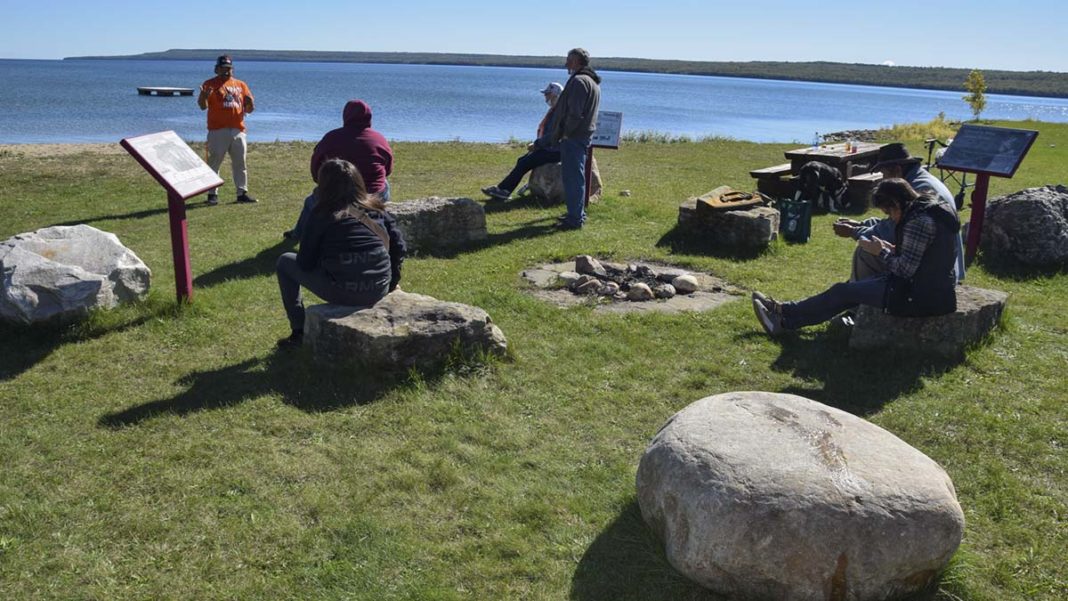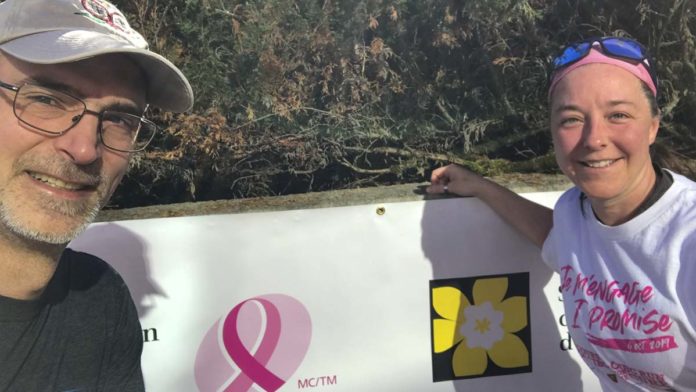WIIKWEMKOONG—Recognizing the need for a better understanding of what the words “truth” and “reconciliation” mean, Wiikwemkoong Tourism has come up with an innovative approach to defining what those words mean, viewed through an Indigenous lens: reconciliation tours.
Wiikwemkoong Tourism has developed educational tours of the community focussed on the Manitoulin treaties, the history behind how those treaties came to be and the residential school system that impacted generations of community members and whose legacy still reverberates through the community.
Guide Jack Rivers, son of Paul Williams baa, spent countless hours poring over the available historical documents, both those in the community archives and documents and books collected by his late father. During the three-hour tour, the eloquent Mr. Rivers provided an engaging and concise synopsis of what he discovered during those research expeditions.
In addition to providing the groundwork for developing the reconciliation tours, the research conducted by Wiikwemkoong Tourism has provided foundation for that organization’s regular summer tours provided to cruise ship visitors and other tourists seeking to learn more about the community.
First stop on the tour was at Two O’Clock, a community near the southern border of the Wiikwemkoong Unceded Territories. The location was as poignant as it was breathtaking, overlooking Manitowaning Bay and the sites of the original gatherings between the Indigenous inhabitants of the Island and the representatives of the Crown who came asking to share the land.
After warning that some of the terms he would be using might be upsetting for some listeners (but were necessary for the historical context) Mr. Rivers went on to provide a 40-minute lecture on the history of Odawa Mniss (“home of the Odawa,” the community’s original name used by its pre-contact inhabitants) and the various treaties impacting Manitoulin, from the Bond Head Treaty of 1836 in which Manitoulin and its surrounding islands were set aside as a “home for the Red Man” to the controversial 1862 treaty that sought to open the Island up for white settlers after the failure of the 1836 Treaty that had sought to encourage Indigenous people from across the North to settle on Manitoulin.
The skullduggery involved in the 1862 Treaty has remained infamous, if not resolved, since even before the ink had dried on the parchment—a fact well-documented in the historical record.
The tour then moved on to the ruins of the old Jesuit residence whose stark walls still tower beside Holy Cross Mission Church, a vivid reminder of the early days of the residential school system.
Those on the tour learn another spot located behind these ruins, now heavily overgrown and hidden from sight by vegetation, the site of the original girls’ school and the location, now long gone, of the corresponding boys’ school located lower down the slopes of the hill leading to the bay.
These original residential schools at Wiikwemkong were, before 1920, relocated to the mouth of the Spanish River on the North Shore of the North Channel of Like Huron.
Mr. Rivers spoke of the sometimes-challenging relationship between the Jesuits and the greater Catholic Church at large, and the critical role the Jesuits living in Wiikwemkoong in 1862 played in explaining the shortcomings of the 1862 Treaty, going on to explain how church and state came together to impose the residential school system on Indigenous communities.
Following the visit to the ruins, the tour bus descended to the shoreline where Mr. Rivers told the story of the “Manitoulin Incident,” an infamous incident involving fishing rights and death and the mistreatment of Indigenous rights, freedoms and sovereignty that reverberated in newspapers around the world. It was an incident that would have dire consequences for the enforcement of Indigenous rights as it was in the immediate aftermath of the legal battle that ensued from the Manitoulin Incident that the Indian Act came into being—an Act that disallowed Indigenous peoples the right to hire a lawyer, preventing the settlement of land claim issues even to the present day.
The Manitoulin Incident involved disputes between the Indigenous landowners and French and English Canadian fishermen who were illegally fishing in the area that eventually devolved into the landing of special constables in Wiikwemkoong and an ensuing tussle that sent the constables and the Crown agent William Gibbard packing. Mr. Gibbard later died under suspicious circumstances while travelling on the same ship as two of the proponents of the original conflict, Chief Ozawanimiki, the Wiikwemkoong fishing chief, and a prominent Jesuit priest from Wiikwemkoong. Mr. Gibbard’s body eventually washed up onshore near Little Current. Despite a complete lack of evidence, the priest and Chief Ozawanimiki were arrested, clapped in irons for murder.
The two were later exonerated and the death of Mr. Gibbard remains a mystery to the present day.
“There is so much history that I don’t have time to go into on this tour,” apologized Mr. Rivers at the conclusion of the tour, despite its three-hour run.
The tour was both informative and enjoyable, given the outstanding visual backdrop of the stopping locations. To book a Reconciliation Tour of Wiikwemkoong, contact Wiikwemkoong Tourism online at Wiikwemkoong.ca/tours, or call 705-859-3477 or by email at info@wiikwemkoong.ca.





